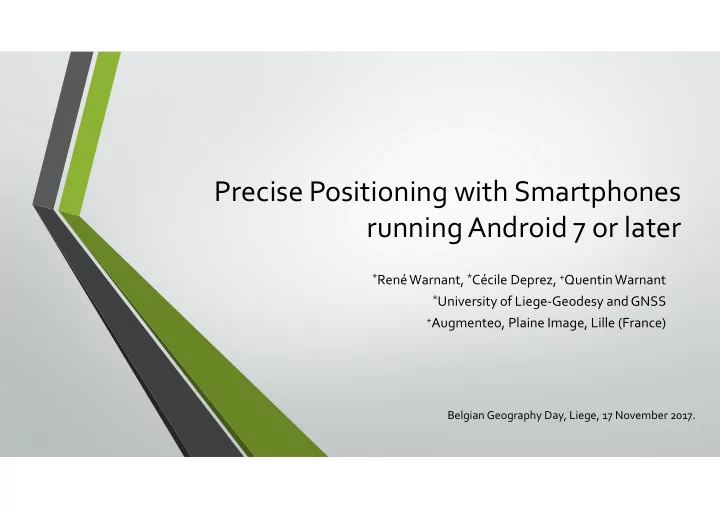

Precise Positioning with Smartphones running Android 7 or later * René Warnant, * Cécile Deprez, + Quentin Warnant * University of Liege ‐ Geodesy and GNSS + Augmenteo, Plaine Image, Lille (France) Belgian Geography Day, Liege, 17 November 2017.
GNSS Market and Smartphones • In 2017 : 5,8 billions GNSS devices • GNSS market is dominated by smartphones (more than 80% of total market) • Forecast for 2020 : 8 billions GNSS devices 2 From GSA market report 2017
Smartphones: which GNSS sensors ? • Recent high ‐ end smartphones are multi ‐ constellation: • GPS (USA, operational) • GLONASS (Russia, operational) • Beidou (China, operational in 2020) • Galileo (Europe, operational in 2020) • QZSS (Japanese regional navigation system) • Single frequency (L1/B1/E1) at the present time. • ! In September 2017, Broadcom announced the availability of a dual frequency chipset (GPS L1/L5, Galileo E1/E5a) for smartphones ! Dual frequency smartphones should be available in 2018 ! 3
Positioning under IOS or Android up to v6 • The smartphone only provides the user with computed position and some ancillary information about satellites (azimuth, elevation, health, …). • Users do not have access to raw GNSS measurements. • The position is computed based on a “manufacturer receipt” which is not documented (Black Box !) • Depending on the model, the position can be obtained from sensor fusion, for example from GNSS, WIFI, inertial sensors, … • No information about integrity (does the computed position fit my requirements ?) 4
Positioning under Android 7 or later 1 • During it “I/O 2016” (June 2016), Google announced that the raw GNSS measurements collected by devices running Android 7 would be made available to users. • This announcement opens new opportunities ! • Indeed, the development of advanced processing strategies might lead to decimeter ‐ level positioning capabilities allowing the emergence of new applications. 5
Positioning under Android 7 or later 2 • Google also decided to provide support for developers who wish to write new applications based on raw GNSS data. • For example, the Google “GNSSLogger” application allows to log raw GNSS data on compatible smartphones (for the moment, only a few devices). • Free processing tools are also available. 6
Android v>7 : which raw data ? • Code pseudorange • The basic GNSS observable used in navigation. • Doppler • Gives information on user velocity. • Carrier phase pseudorange • The necessary observable for precise positioning • ! VERY UNEXPECTED to have this observable on smartphones ! 7
Android v>7 : which positioning technique 1 ? • Standard “standalone” positioning • Code ‐ based only (no improvement expected). • Code + Doppler • To smooth noisy code • The user velocity obtained from Doppler gives a constraint on the “acceptable” position change from epoch to epoch. • Code smoothing with phase (not successful at the present time due to duty cycle) 8
Horizontal position repeatability (static case) 15 minutes of Samsung Galaxy S8 GPS code measurements (static smartphone) Kalman filter using Code + Doppler Standard WLS with Code 9
Android v>7 : which positioning technique 2 ? • Differential Positioning • Code ‐ based (+ Doppler) • Phase ‐ based (Real Time Kinematics) ! Might lead to sub ‐ decimetre positioning with dual frequency smartphones ! • Precise Point Positioning (PPP) • Requires precise clocks and orbits but no “external” raw data. • Slow convergence time. • Fused sensors (GNSS + other Smartphone sensors, in particular, inertial sensors) • Development of RAIMS Information on integrity ! 10
Main weaknesses • Smartphone antenna • Low ‐ quality linearly polarized antenna optimized for voice communication but not for navigation signals which are circularly polarized (right ‐ handed). • Very susceptible to multipath (in particular in urban environment). • No information about antenna phase centre (mandatory for precise positioning). • Duty cycle • Smartphone components are regularly switched off and on to save battery life (including navigation filter) • This results in discontinuous carrier phase measurements • From Android 8, Google considers to insert an option (under developers options) allowing to switch the duty cycle off. • Battery Life 11
Applications • Any application which requires cheap and quick precise positioning • Location ‐ based services • Virtual (augmented) reality • Autonomous car • Earth Sciences/Earth Observation • Precise positioning • Atmosphere Monitoring (Ionosphere and Water vapour) • ? Reflectometry ? (soil moisture, …) • Millions of smartphones might send atmospheric information through the internet to a central computing facility allowing to feed models 12
Conclusion • The availability of dual frequency multi ‐ constellation GNSS raw code, phase and Doppler data on smartphones running android v>7 might lead to sub ‐ decimetre real ‐ time positioning within the next few years. • Important benefits for “every ‐ day ‐ life” applications and also in Earth Sciences. 13
Recommend
More recommend